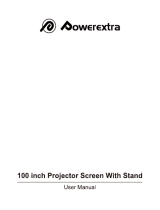
English-
3
INDEX
Warning, Notices, and Safety Instructions 4
Notice 4
Contents of package 4
Do not open 4
About Electro-Magnetic Interference 4
Description pertaining to FCC Rules Part 15 4
Disposal of Old Equipment and Batteries Only for
European Union and countries with recycling systems 5
Sunlight Warning 5
Never look into the projector light source directly 5
Keep any object away from concentrated projection light beam
5
Electric shock 5
Do not overload outlets/extension cords 6
Cleaning 6
Dampness, smoke, steam, dust, high temperature and direct
exposure to sunlight 6
Ventilation 6
Intrusion of foreign objects 6
&RROLQJÀXLG
Carrying the projector 6
Install the projector on an even and stable surface 7
Servicing 7
Replacing parts 7
Power cord 7
Notices you should read prior to the installation of the
projector 8
Installation environment for the projector 8
&RQ¿JXUDWLRQVIRUSURMHFWRURSHUDWLRQDWKLJKDOWLWXGHV
Protect the projector with care 8
Keep obstacles away from the projector's ventilation
inlets and outlets 8
Positioning Precautions 9
Take frequent breaks to rest your eyes 10
Caution for 3D 10
LASER WARNING 11
CLASS 3R LASER PRODUCT 11
Laser Parameters 11
Product labels 12
Location of laser aperture 14
Interlock switches 14
Projector parts and functions 15
Front view 15
LED indicator 15
Rear view 16
Control panel 16
Ports 17
Bottom view 18
Effective range of remote control signal 19
Installing batteries in the remote control 19
Installation of the projector 20
1. Installing the projector towards the screen 20
2.
Removing the mount cap on the projector 20
3.
Selecting the correct input voltage depending
on your area 20
4.
Connecting the power cord to the projector 20
5.
Connecting the projector to your PC and
VZLWFKLQJWR³ʜ´WRWXUQRQWKHSRZHU
20
6. Starting up the projector 21
7. Adjusting the projector's angle, Lens Shift,
Zoom, Lens Centering, and Focus 21
8. Correcting the distortion 22
9. Turning off the projector 23
Throw distance 24
Modes of installation 24
Front/Desktop 24
Front/Ceiling 25
Rear/Desktop 25
Rear/Ceiling 25
Rear with a Mirror 25
Horizontal and vertical lens shift 26
Moving the lens vertically 26
Moving the lens horizontally 26
Connecting the projector to other devices 27
HDMI / DVI connection 27
12V OUTPUT connection 27
RGB connection 28
HDBaseT / LAN connection 28
SDI connection 29
Turning on the projector 29
Changing OSD language 29
Adjusting screen position 30
Front/Ceiling 30
Rear/Desktop 30
Rear/Ceiling 31
Adjusting the projector lens 31
Warranty and after-service 31




















